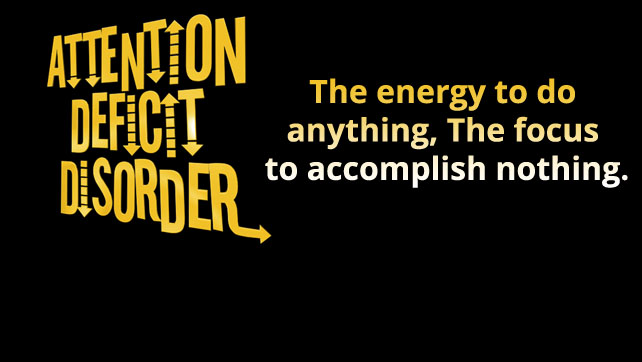
Life In The Fast Lane
I wrote this essay in high school in early 2003. It was my first college research paper and I picked a topic that was important to me. I'm posting it here to have it for my son Jett to read one day. Here it is, slightly tweaked for readability and accuracy: Dealing With Attention Deficit Disorder in High School
“If you do not do something about your child I will retire from teaching! I simply cannot control him.”
That was what my kindergarten teacher told my mother one afternoon. My constant interruptions in class had worn her thin. What frustrated me the most was that I wasn’t trying to be disruptive—I was sincerely sorry and wanted to change, but struggled with change all my life. Soon after, I was referred to doctors and tested. My parents were told initially that my symptoms sound like either bipolar disorder or ADHD, but after extensive testing was eventually diagnosed with ADHD (Attention Deficit Hyperactivity Disorder).
Understanding ADHD
ADHD—Attention-Deficit/Hyperactivity Disorder—is not simply a matter of being “lazy” or “unmotivated.” It is a recognized neurodevelopmental disorder that affects the brain’s executive functioning system. This system controls skills such as working memory, impulse control, emotional regulation, planning, and sustained attention. When those functions are disrupted, daily life becomes a constant uphill battle.
Research shows that ADHD is tied to differences in brain structure and connectivity, particularly in areas like the prefrontal cortex (responsible for focus and decision-making), the basal ganglia (involved in motivation and reward processing), and the cerebellum (linked to timing and coordination). Brain imaging studies reveal that people with ADHD often have altered patterns of activity in the “default mode network,” the brain system that drifts when your mind wanders. For someone with ADHD, that wandering switch flips on more often—and makes it harder to stay anchored to the task at hand.
Neurochemically, dopamine and norepinephrine play a major role. These neurotransmitters regulate attention, reward, and motivation. In ADHD brains, dopamine signaling is often less efficient, which helps explain why tasks that are boring, repetitive, or lack immediate payoff can feel almost impossible, while activities that are interesting or stimulating can capture laser-like focus. This isn’t a matter of willpower—it’s biology. That’s why many people with ADHD describe themselves as either “all in” or “checked out,” with very little middle ground.
Genetics also have a powerful influence. Studies consistently show that ADHD runs in families. If one parent has ADHD, their child has about a 40–60% chance of also having it. Twin studies suggest heritability rates as high as 70–80%, making it one of the most genetically influenced mental health conditions.
It’s also important to note that ADHD isn’t one-size-fits-all. The DSM-5 identifies three main presentations:
- Inattentive type (ADHD-I): More daydreaming, disorganization, and forgetfulness.
- Hyperactive-impulsive type (ADHD-HI): More fidgeting, restlessness, and impulsive decisions.
- Combined type (ADHD-C): A mix of both.
This variety is part of why so many kids, especially girls, go undiagnosed—because their symptoms don’t always look like the stereotypical “hyper kid bouncing off the walls.” Girls are more likely to show inattentiveness rather than hyperactivity, which can be misread as shyness or lack of effort.
Finally, ADHD is not limited to childhood. Roughly two-thirds of kids with ADHD continue to have symptoms into adulthood. Untreated ADHD in adults can affect relationships, jobs, and self-esteem, but with recognition and support, many people go on to thrive. The disorder doesn’t go away, it’s managed, adapted to, and in many cases, transformed into a source of creativity, energy, and resilience.
Living With ADHD
Living with ADHD is more than just struggling to pay attention—it touches every corner of life. My specific diagnosis is ADD/I/WO—Attention Deficit Disorder, Inattentive type, without hyperactivity. This means my struggles weren’t as obvious as the “hyperactive kid bouncing off the walls.” Instead, I dealt with selective inattention, forgetfulness, daydreaming, impulsivity in conversations, anxiety, and a low tolerance for frustration. On the outside, that looked like laziness or carelessness. On the inside, I cared deeply but felt trapped in a brain that wouldn’t stay on track.
Teachers assumed I wasn’t trying, when in reality I was fighting harder than anyone knew. Every assignment felt like climbing a mountain with loose gravel under my shoes: exhausting, slippery, and discouraging. The worst part wasn’t just the distraction—it was the shame of always being told I “could do better if I just applied myself.”
Medication helped me find some footing. Ritalin was my first prescription, and it gave me clarity I’d never experienced before. My thoughts lined up, my anxiety quieted, and for once, I could follow through. But the side effects were brutal—painful stomach cramps that eventually led to an ulcer. Switching to Adderall gave me similar focus without the same intensity of side effects, though it crushed my appetite. With Adderall, I finally had some control over my wandering mind, but it was never a cure. Medication doesn’t teach organization, build study habits, or stop you from forgetting to turn in a paper you already finished. It’s a tool, not a magic wand.
That’s the reality of ADHD, especially the inattentive type: even with treatment, the challenges remain. That’s why many people—myself included—need more than medication. Cognitive Behavioral Therapy (CBT) helps break tasks into smaller steps and counter the constant shame spiral of feeling “not enough.” Exercise acts like natural medicine, boosting dopamine and norepinephrine levels that the ADHD brain lacks. Even simple things like sleep and nutrition make a huge difference, though ironically, ADHD makes it harder to stick to healthy routines.
Perhaps the hardest part of living with ADHD is the emotional weight. People with ADHD often feel emotions more intensely—a phenomenon called emotional dysregulation. A small setback, like forgetting homework, can feel like a crushing failure. Criticism cuts deep. And after years of hearing that you’re lazy or unmotivated, you start to internalize it. That’s why so many people with inattentive ADHD develop low self-esteem alongside their symptoms.
But ADHD also comes with moments of brilliance. My diagnosis didn’t just explain my struggles; it also helped me understand my strengths. When I find something I’m passionate about, I fall into hyperfocus, a state where hours vanish and my productivity skyrockets. That’s why ADHD often looks inconsistent from the outside—one day I’m distracted, the next I’m unstoppable. The truth is that my brain runs on interest, not obligation.
Socially, inattentive ADHD can be tricky. I’ve interrupted conversations, drifted off in the middle of important discussions, or forgotten key details with friends. At the same time, ADHD gives me humor, creativity, and big-hearted energy that people appreciate once they understand me. Relationships take patience, but when someone meets me halfway, I thrive.
Living with ADHD means constantly adjusting. I rely on lists, alarms, planners, and reminders just to keep pace. Sometimes I still lose things, miss deadlines, or wander off mid-task. But over time, I’ve learned that my diagnosis isn’t a label of failure—it’s a roadmap. It gave me language to explain what I’d been going through all along. Now, instead of trying to “fix” myself, I build systems that work with my brain instead of against it.
Misconceptions and Reality
One of the biggest obstacles to living with ADHD isn’t just the symptoms—it’s how people see them. For years, I was told I was “lazy,” “unmotivated,” or that I just needed to “try harder.” Those words sting because they’re not true. ADHD doesn’t mean a lack of effort. In fact, most of us with ADHD are constantly putting in extra energy just to keep up. What looks like carelessness on the outside is usually exhaustion from fighting an invisible uphill battle.
A common misconception is that ADHD is simply a childhood phase or the result of bad parenting. Neither is true. ADHD is a neurodevelopmental condition with biological roots that usually continues into adulthood. Hyperactivity may fade with age, but the executive function challenges—disorganization, poor time management, forgetfulness, and emotional intensity—often remain. For adults, this can affect careers, relationships, and self-esteem just as much as schoolwork did in childhood.
Then there’s the debate about whether ADHD is “overdiagnosed.” On the surface, it can feel that way. Rates of diagnosis have risen sharply over the last few decades, especially in the U.S., and stories of college students misusing stimulants like Adderall add fuel to that perception. Some kids do get labeled with ADHD when the real issue might be trauma, anxiety, or simply being in an overly rigid school environment. That’s where the overdiagnosis concern comes from.
But the other side of the story is underdiagnosis—and it’s just as real. Many children and adults go years, even decades, without recognition. Girls and women, people of color, and those with the inattentive type (like mine, ADD/I/WO) are especially overlooked. Because they don’t fit the stereotype of the “hyperactive little boy bouncing off the walls,” their struggles are written off as laziness, daydreaming, or lack of discipline. By the time they finally get diagnosed, they’ve often internalized years of shame and failure. So ADHD is both over- and underdiagnosed—it depends on who you are, where you live, and whether you match the narrow picture people expect.
Another myth is that ADHD medication is a “crutch.” Critics argue that it’s overprescribed or that parents medicate their kids just to make them easier to control. But medication doesn’t hand out shortcuts. It doesn’t make you smarter or teach you study habits. It simply gives ADHD brains access to the focus and calm that neurotypical students already have by default. As I learned firsthand, the pills don’t guarantee success—they just give you a fighting chance. Without them, school feels like trying to run a marathon in quicksand.
People also assume ADHD means you’re unfocused all the time, but that’s only half the story. The flip side is hyperfocus—getting locked into a project or passion so completely that hours disappear. To outsiders, this looks inconsistent: “Why can you sit at a computer for six hours but not finish a worksheet?” The truth is that ADHD brains are wired for interest, novelty, and urgency—not obligation. When the task is stimulating, we come alive. When it isn’t, it feels impossible. That inconsistency is one of the hardest realities to explain to people who don’t live with it.
Finally, the most damaging misconception is that ADHD is a weakness. Yes, it brings challenges—school, work, and relationships can be tougher. But ADHD also comes with unique strengths: creativity, humor, resilience, and a tendency to think outside the box. Some of history’s greatest innovators showed ADHD traits, and many modern creators credit their success to the very qualities others once scolded them for. The reality is that ADHD isn’t about being broken. It’s about being wired differently—and when understood and supported, those differences can become powerful strengths.
The Science Behind It
To truly understand ADHD, you have to go beyond the surface behaviors and look inside the brain. ADHD isn’t about being “bad at paying attention”—it’s about how the brain’s executive function system is wired. Executive functions are like the brain’s management team: they organize, plan, prioritize, regulate emotions, and control impulses. In ADHD, those systems work differently, and that difference shows up in everyday life.
Brain Structure and Function
Brain imaging studies (fMRI, PET scans) consistently show differences in regions linked to focus, self-regulation, and motivation. The prefrontal cortex, the part of the brain that handles decision-making and impulse control, tends to develop more slowly in ADHD brains. The basal ganglia, which regulate motivation and reward, also function differently, helping explain why tasks without immediate payoff feel impossible. The cerebellum, known for coordination, timing, and rhythm, shows structural differences as well. Together, these variations create the mix of distractibility, impulsivity, and inconsistent performance that define ADHD.
Another key player is the default mode network (DMN)—the system the brain uses when it’s at rest or daydreaming. In neurotypical people, the DMN quiets down when they switch to a task-focused state. In ADHD brains, the DMN often stays active, making it much easier for attention to drift. This is why focusing on routine or boring tasks feels like wrestling with your own mind.
Neurotransmitters and Chemistry
The older explanation of ADHD as a simple “chemical imbalance” isn’t wrong, but it’s incomplete. What we know now is that the main neurotransmitters involved are dopamine and norepinephrine. These chemicals regulate attention, reward, and motivation. In ADHD brains, the transmission of dopamine and norepinephrine signals is less efficient.
This explains two classic ADHD paradoxes:
Why boring, repetitive tasks feel unbearable (not enough dopamine released).
Why exciting, stimulating, or urgent tasks create laser-sharp focus (hyperfocus).
Stimulant medications like Ritalin and Adderall don’t “fix” ADHD—they boost dopamine and norepinephrine activity, essentially leveling the playing field. That’s also why these drugs make non-ADHD people feel wired or overstimulated: their brains don’t have the same deficiency.
Genetics and Heritability
ADHD is one of the most heritable psychiatric conditions, with studies suggesting 70–80% of the risk is genetic. If a parent has ADHD, their child has a much higher chance of inheriting it. Twin studies show that identical twins are far more likely to both have ADHD than fraternal twins. Researchers have even identified specific gene variations linked to dopamine regulation (like the DRD4 and DAT1 genes) that are more common in people with ADHD.
But genetics aren’t the whole story. Environmental factors—like prenatal exposure to nicotine or alcohol, premature birth, or early childhood stress—can increase the likelihood of symptoms. ADHD isn’t caused by one thing; it’s the result of multiple influences stacking together.
The Complexity of Diagnosis
One of the challenges in diagnosing ADHD is that many symptoms—like restlessness, forgetfulness, or inattention—are common in all children at some point. The line between normal behavior and clinical ADHD is about degree and impact. For a diagnosis, symptoms must be consistent, persistent, and impairing across settings (school, home, work). This explains why some kids go undiagnosed for years, while others may be misdiagnosed when the real issue is anxiety, trauma, or a learning disability.
Strengths of ADHD
Despite the struggles, ADHD often comes with unique strengths. ADHD kids tend to be fearless, energetic, optimistic, and intensely passionate about their interests. Once we find something we love, we can hyperfocus for hours and excel.
For example, my friend Ben and I once built a custom computer system with wireless remote-controlled LED lights circling the processor. Another friend, Willie, rigged up electronics from scratch just for fun. ADHD doesn’t limit creativity—it amplifies it.
Being diagnosed was liberating. It explained why I couldn’t focus, lifting years of shame and self-doubt. As one eight-year-old with ADD once put it:
“I’ve always wondered why so many kids feast at the table of knowledge, when all I get is indigestion.”
That quote sums up what it feels like to be ADHD—capable but constantly blocked by distractions.
The Bigger Picture
Research shows ADHD often runs in families. My own father told me his grandfather struggled with the same symptoms. Genetics, brain chemistry, and environment all play a role. And while ADHD increases risks—students untreated are more likely to drop out, abuse drugs, or struggle later in life—it doesn’t have to be that way.
In fact, some of the most influential people in history reportedly had ADHD or similar traits: Albert Einstein, Walt Disney, Robin Williams, Will Smith, Whoopi Goldberg, Babe Ruth, Magic Johnson, John D. Rockefeller, and more. With support, ADHD isn’t a dead end—it’s simply a different path.
Moving Forward
Being ADHD is not easy. We need more help than most, but with the right guidance, we can thrive. I have big dreams: a home, a family, a successful career. I know it won’t be easy, and I’ll need support. But as the saying goes: If you shoot for the moon and miss, you’ll land among the stars.
What ADHD has given me is resilience, optimism, and an unshakable confidence. With hope and hard work, I’ll keep racing forward in life’s fast lane.
Works Cited
Dendy, Chris A. Zeigler. Teenagers with ADD: A Parent’s Guide. Woodbine, 1995.
Wender, Paul H. ADHD: Attention-Deficit Hyperactivity Disorder in Children and Adults. Oxford, 2000.
Neuwirth, Sharyn. “Attention Deficit Hyperactivity Disorder.” National Institute of Mental Health, July 1999.
Adams, Paul. “No More Ritalin.” nomoreritalin.com, Oct. 23, 2002.

